Application of a GIS-Based Slope Unit Method for Landslide Susceptibility Mapping along the Longzi River, Southeastern Tibetan Plateau, China
Abstract
:1. Introduction
2. Methodology
2.1. The Mapping Unit
2.2. The Analytic Hierarchy Process
- The first step is to establish a hierarchy model.
- Judgement matrices are constructed through pairwise comparison. The results of comparison between the different factors are scored on a 1~9 scale method, and factors are assigned different values according to their importance (Table 1). The judgement matrix = (aij) is established as follows:
- The judgement matrix must satisfy the following formula:where is the largest eigenvalue of the judgement matrix , and is the eigenvector corresponding to .
- The AHP requires a consistency of the judgement matrix in order to ensure that the calculation results are reasonable. The random consistency ratio is required to satisfy the following formula:where is the order of the judgement matrix , is the consistency index of the judgement matrix , and is the random index, which is listed in Table 2.
2.3. The Information Content Model
- The information content of each factor that influences landslide occurrence is calculated separately:where is the probability of occurrence of in the landslide area, and is the probability of occurrence of in the study area.where is the number of landslide pixels in the study area, is the total number of pixels in the study area, is the number of pixels for factor in the landslide area, and is the number of pixels for factor in the study area.
- Calculate the total amount of information content for each factor :where is the total amount of information content for factor . The greater the value, the more likely the landslide will occur.
2.4. The Landslide Susceptibility Assessment
3. Study Area and Data
3.1. Study Area
3.2. Influencing Factors
4. Results
4.1. Determination of AHP Weights
4.2. The Information Content (IC) of the Eight Factors
4.3. Landslide Susceptibility Mapping
4.4. Validation
5. Discussion
5.1. Application of AHP-ICM
5.2. Evaluation Results of the Slope Units
5.3. Comparative Analysis of Slope Units and Grid Units
6. Conclusions
Acknowledgments
Author Contributions
Conflicts of Interest
References
- Chalkias, C.; Ferentinou, M.; Polykretis, C. GIS supported landslide susceptibility modeling at regional scale: An expert-based fuzzy weighting method. ISPRS Int. J. Geo-Inf. 2014, 3, 523–539. [Google Scholar] [CrossRef]
- Youssef, A.M.; Pourghasemi, H.R.; Pourtaghi, Z.S.; Al-Katheeri, M.M. Landslide susceptibility mapping using random forest, boosted regression tree, classification and regression tree, and general linear models and comparison of their performance at Wadi Tayyah Basin, Asir Region, Saudi Arabia. Landslides 2016, 13, 839–856. [Google Scholar] [CrossRef]
- Pourghasemi, H.R.; Kerle, N. Random forests and evidential belief function-based landslide susceptibility assessment in western Mazandaran Province, Iran. Environ. Earth Sci. 2016, 75, 1–17. [Google Scholar] [CrossRef]
- Lee, S.; Pradhan, B. Landslide hazard mapping at selangor, malaysia using frequency ratio and logistic regression models. Landslides 2007, 4, 33–41. [Google Scholar] [CrossRef]
- Pourghasemi, H.R.; Pradhan, B.; Gokceoglu, C. Remote sensing data derived parameters and its use in landslide susceptibility assessment using Shannon’s entropy and GIS. Appl. Mech. Mater. 2012, 225, 486–491. [Google Scholar] [CrossRef]
- Bui, D.T.; Pradhan, B.; Lofman, O.; Revhaug, I.; Dick, O.B. Application of support vector machines in landslide susceptibility assessment for the Hoa Binh Province (Vietnam) with kernel functions analysis. In Proceedings of the iEMSs Sixth Biennial Meeting, Leipzig, Germany, 1–5 July 2012. [Google Scholar]
- Pourghasemi, H.R.; Pradhan, B.; Gokceoglu, C. Application of fuzzy logic and analytical hierarchy process (AHP) to landslide susceptibility mapping at Haraz watershed, Iran. Nat. Hazards 2012, 63, 965–996. [Google Scholar] [CrossRef]
- Hou, W.; Lu, X.; Wu, P.; Xue, A.; Li, L. An integrated approach for monitoring and information management of the Guanling Landslide (China). ISPRS Int. J. Geo-Inf. 2017, 6, 79. [Google Scholar] [CrossRef]
- Chhetri, S.K.; Kayastha, P. Manifestation of an analytic hierarchy process (AHP) model on fire potential zonation mapping in kathmandu metropolitan city, Nepal. ISPRS Int. J. Geo-Inf. 2015, 4, 400–417. [Google Scholar] [CrossRef]
- Bui, D.T.; Lofman, O.; Revhaug, I.; Dick, O. Landslide susceptibility analysis in the Hoa Binh Province of Vietnam using statistical index and logistic regression. Nat. Hazards 2011, 59, 1413. [Google Scholar] [CrossRef]
- Pourghasemi, H.; Moradi, H.; Aghda, S.F. Landslide susceptibility mapping by binary logistic regression, analytical hierarchy process, and statistical index models and assessment of their performances. Nat. Hazards 2013, 69, 749–779. [Google Scholar] [CrossRef]
- Conforti, M.; Pascale, S.; Robustelli, G.; Sdao, F. Evaluation of prediction capability of the artificial neural networks for mapping landslide susceptibility in the Turbolo River Catchment (northern Calabria, Italy). Catena 2014, 113, 236–250. [Google Scholar] [CrossRef]
- Zare, M.; Pourghasemi, H.R.; Vafakhah, M.; Pradhan, B. Landslide susceptibility mapping at Vaz watershed (Iran) using an artificial neural network model: A comparison between multilayer perceptron (MLP) and radial basic function (RBF) algorithms. Arab. J. Geosci. 2013, 6, 2873–2888. [Google Scholar] [CrossRef]
- Bui, D.T.; Tuan, T.A.; Klempe, H.; Pradhan, B.; Revhaug, I. Spatial prediction models for shallow landslide hazards: A comparative assessment of the efficacy of support vector machines, artificial neural networks, kernel logistic regression, and logistic model tree. Landslides 2016, 13, 361–378. [Google Scholar]
- Pourghasemi, H.R.; Jirandeh, A.G.; Pradhan, B.; Xu, C.; Gokceoglu, C. Landslide susceptibility mapping using support vector machine and GIS at the Golestan Province, Iran. J. Earth Syst. Sci. 2013, 122, 349–369. [Google Scholar] [CrossRef]
- Cao, C.; Xu, P.; Wang, Y.; Chen, J.; Zheng, L.; Niu, C. Flash flood hazard susceptibility mapping using frequency ratio and statistical index methods in coalmine subsidence areas. Sustainability 2016, 8, 948. [Google Scholar] [CrossRef]
- Park, S.; Choi, C.; Kim, B.; Kim, J. Landslide susceptibility mapping using frequency ratio, analytic hierarchy process, logistic regression, and artificial neural network methods at the Inje area, Korea. Environ. Earth Sci. 2013, 68, 1443–1464. [Google Scholar] [CrossRef]
- Pourghasemi, H.R.; Rossi, M. Landslide susceptibility modeling in a landslide prone area in Mazandarn Province, north of Iran: A comparison between GLM, GAM, MARS, and M-AHP methods. Theor. Appl. Climatol. 2016, 1–25. [Google Scholar] [CrossRef]
- Nefeslioglu, H.A.; Sezer, E.A.; Gokceoglu, C.; Ayas, Z. A modified analytical hierarchy process (M-AHP) approach for decision support systems in natural hazard assessments. Comput. Geosci. 2013, 59, 1–8. [Google Scholar] [CrossRef]
- Cao, C.; Wang, Q.; Chen, J.; Ruan, Y.; Zheng, L.; Song, S.; Niu, C. Landslide susceptibility mapping in vertical distribution law of precipitation area: Case of the xulong hydropower station reservoir, southwestern China. Water 2016, 8, 270. [Google Scholar] [CrossRef]
- Cox, N. Hillslope profile analysis (comment). Area 1978, 10, 131–133. [Google Scholar]
- Francou, B.; Manté, C. Analysis of the segmentation in the profile of Alpine Talus Slopes. Permafrost Periglac. Process. 1990, 1, 53–60. [Google Scholar] [CrossRef]
- Savigear, R. The Analysis and Classification of Slope Profile Forms; Université de Liège: Liège, Belgium, 1967. [Google Scholar]
- Carrara, A.; Cardinali, M.; Detti, R.; Guzzetti, F.; Pasqui, V.; Reichenbach, P. GIS techniques and statistical models in evaluating landslide hazard. Earth Surf. Process. Landf. 1991, 16, 427–445. [Google Scholar] [CrossRef]
- Carrara, A.; Cardinali, M.; Guzzetti, F. Uncertainty in assessing landslide hazard and risk. ITC J. 1992, 2, 172–183. [Google Scholar]
- Carrara, A.; Cardinali, M.; Guzzetti, F.; Reichenbach, P. GIS technology in mapping landslide hazard. In Geographical Information Systems in Assessing Natural Hazards; Springer: Dordrecht, The Netherlands, 1995; pp. 135–175. [Google Scholar]
- Guzzetti, F.; Cardinali, M. Landslide inventory map of the Umbria Region, central Italy. Proc. ALPS 1990, 90, 273–284. [Google Scholar]
- Guzzetti, F.; Cardinali, M.; Reichenbach, P. The avi project: A bibliographical and archive inventory of landslides and floods in Italy. Environ. Manag. 1994, 18, 623–633. [Google Scholar] [CrossRef]
- Guzzetti, F.; Cardinali, M.; Reichenbach, P. The influence of structural setting and lithology on landslide type and pattern. Environ. Eng. Geosci. 1996, 2, 531–555. [Google Scholar] [CrossRef]
- Cooper, P.R.; Friedman, D.E.; Wood, S.A. The automatic generation of digital terrain models from satellite images by stereo. Acta Astronaut. 1987, 15, 171–180. [Google Scholar] [CrossRef]
- Ehlers, M.; Welch, R. Stereocorrelation of Landsat TM Images; Food and Agriculture Organization of the United Nations: Rome, Italy, 1987. [Google Scholar]
- Jia, N.; Mitani, Y.; Xie, M.; Djamaluddin, I. Shallow landslide hazard assessment using a three-dimensional deterministic model in a mountainous area. Comput. Geotech. 2012, 45, 1–10. [Google Scholar] [CrossRef]
- Giles, P.T.; Franklin, S.E. An automated approach to the classification of the slope units using digital data. Geomorphology 1998, 21, 251–264. [Google Scholar] [CrossRef]
- Saaty, T.L. Modeling unstructured decision problems—The theory of analytical hierarchies. Math. Comput. Simul. 1978, 20, 147–158. [Google Scholar] [CrossRef]
- Du, J.; Yang, Q.-H.; Yan, J.; Xue, C.-S. Hazard evaluation of secondary geological disaster based on GIS and information value method. Earth Sci. Diqiu Kexue 2010, 35, 324–330. [Google Scholar]
- Gao, K.; Cui, P.; Zhao, C.; Wei, F. Landslide hazard evaluation of wanzhou based on GIS information value method in the Three Gorges Reservoir. Yanshilixue Yu Gongcheng Xuebao 2006, 25, 991–996. [Google Scholar]
- Chen, Y.; Zhou, F.; Feng, Y.; Xia, Y. Breach of a naturally embanked dam on Yalong River. Can. J. Civ. Eng. 1992, 19, 811–818. [Google Scholar] [CrossRef]
- Li, T.; Schuster, R.L.; Wu, J. Landslide dams in south-central China. In Landslide Dams: Processes, Risk, and Mitigation; ASCE: Reston, VA, USA, 1986; pp. 146–162. [Google Scholar]
- Shang, Y.; Yang, Z.; Li, L.; Liu, D.A.; Liao, Q.; Wang, Y. A super-large landslide in Tibet in 2000: Background, occurrence, disaster, and origin. Geomorphology 2003, 54, 225–243. [Google Scholar] [CrossRef]
- Junxia, L.; Wang, C.; Wang, G.; Liu, W. Analysis of landslide influential factors and coupling intensity based on third theory of quantification. Chin. J. Rock Mech. Eng. 2010, 6, 1206–1213. [Google Scholar]
- Li, J.-X.; Wang, C.-M.; Wang, G.-C. Landslide risk assessment based on combination weighting-unascertained measure theory. Rock Soil Mech. 2013, 34, 468–474. [Google Scholar]
- Pradhan, B. Landslide susceptibility mapping of a catchment area using frequency ratio, fuzzy logic and multivariate logistic regression approaches. J. Indian Soc. Remote Sens. 2010, 38, 301–320. [Google Scholar] [CrossRef]
- Lee, S.; Min, K. Statistical analysis of landslide susceptibility at Yongin, Korea. Environ. Geol. 2001, 40, 1095–1113. [Google Scholar] [CrossRef]
- Hong, H.; Pradhan, B.; Xu, C.; Bui, D.T. Spatial prediction of landslide hazard at the Yihuang Area (China) using two-class kernel logistic regression, alternating decision tree and support vector machines. Catena 2015, 133, 266–281. [Google Scholar] [CrossRef]
- Oh, H.-J.; Pradhan, B. Application of a neuro-fuzzy model to landslide-susceptibility mapping for shallow landslides in a tropical hilly area. Comput. Geosci. 2011, 37, 1264–1276. [Google Scholar] [CrossRef]
- Ercanoglu, M.; Gokceoglu, C.; Van Asch, T.W. Landslide susceptibility zoning north of Yenice (NW Turkey) by multivariate statistical techniques. Nat. Hazards 2004, 32, 1–23. [Google Scholar] [CrossRef]
- Nefeslioglu, H.A.; Duman, T.Y.; Durmaz, S. Landslide susceptibility mapping for a part of tectonic kelkit valley (eastern black sea region of Turkey). Geomorphology 2008, 94, 401–418. [Google Scholar] [CrossRef]
- Yilmaz, C.; Topal, T.; Süzen, M.L. GIS-based landslide susceptibility mapping using bivariate statistical analysis in devrek (zonguldak-Turkey). Environ. Earth Sci. 2012, 65, 2161–2178. [Google Scholar] [CrossRef]
- Feizizadeh, B.; Blaschke, T. GIS-multicriteria decision analysis for landslide susceptibility mapping: Comparing three methods for the Urmia Lake Basin, Iran. Nat. Hazards 2013, 65, 2105–2128. [Google Scholar] [CrossRef]
- Xu, W.; Yu, W.; Jing, S.; Zhang, G.; Huang, J. Debris flow susceptibility assessment by GIS and information value model in a large-scale region, Sichuan Province (China). Nat. Hazards 2013, 65, 1379–1392. [Google Scholar] [CrossRef]
- Du, G.-L.; Zhang, Y.-S.; Iqbal, J.; Yang, Z.-H.; Yao, X. Landslide susceptibility mapping using an integrated model of information value method and logistic regression in the Bailongjiang watershed, Gansu Province, China. J. Mt. Sci. 2017, 14, 249–268. [Google Scholar] [CrossRef]
- Guzzetti, F.; Reichenbach, P.; Ardizzone, F.; Cardinali, M.; Galli, M. Estimating the quality of landslide susceptibility models. Geomorphology 2006, 81, 166–184. [Google Scholar] [CrossRef]
- Guzzetti, F. Landslide hazard and risk by GIS-based multivariate models. In Proceedings of the International Workshop GIS in Assessing Natural Hazards, Perugia, Italy, 20–22 September 1993; pp. 20–22. [Google Scholar]
- Shang, Y.; Hyun, C.-U.; Park, H.-D.; Yang, Z.; Yuan, G. The 102 landslide: Human-slope interaction in SE Tibet over a 20-year period. Environ. Earth Sci. 2016, 76, 47. [Google Scholar] [CrossRef]

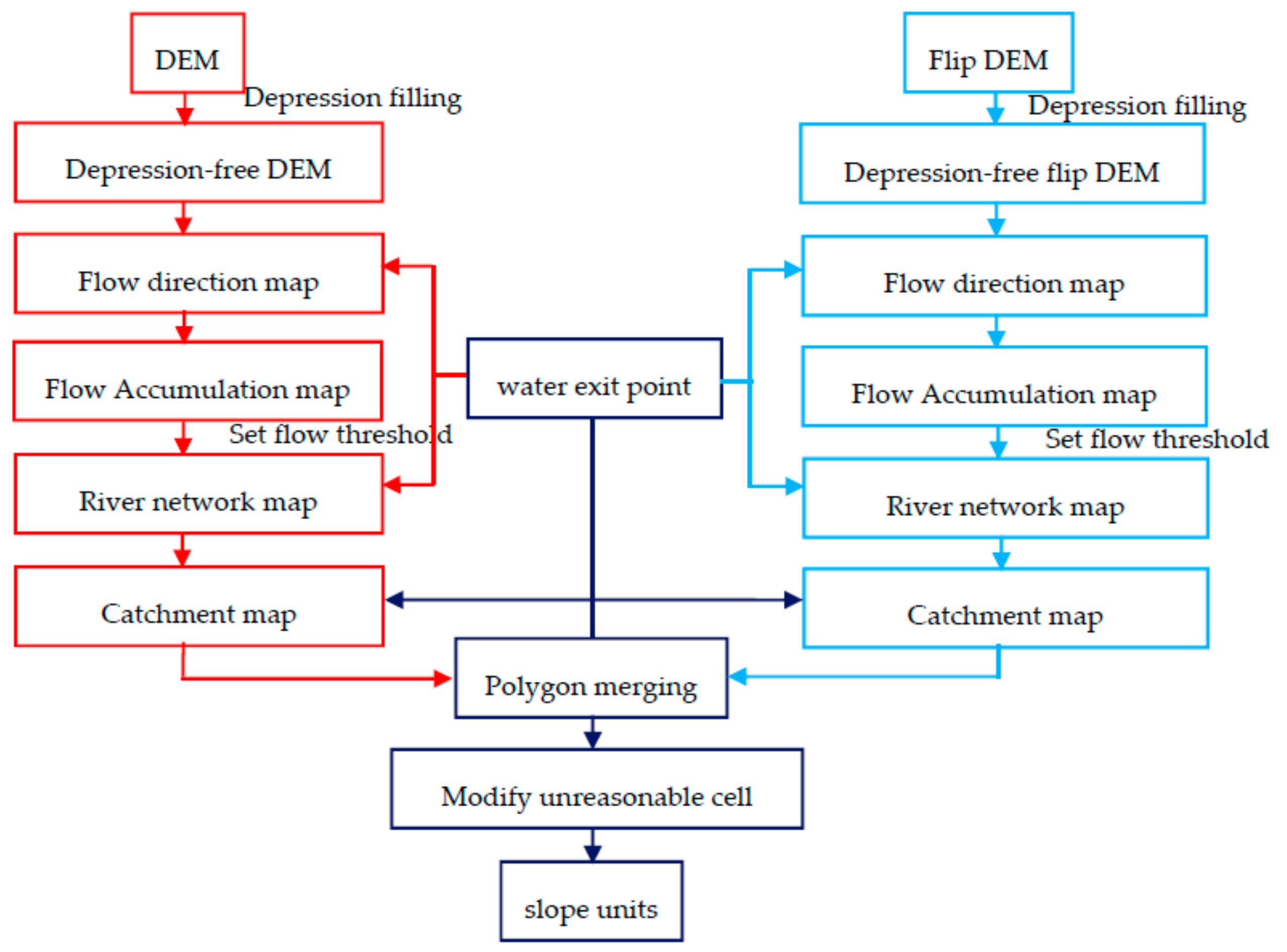
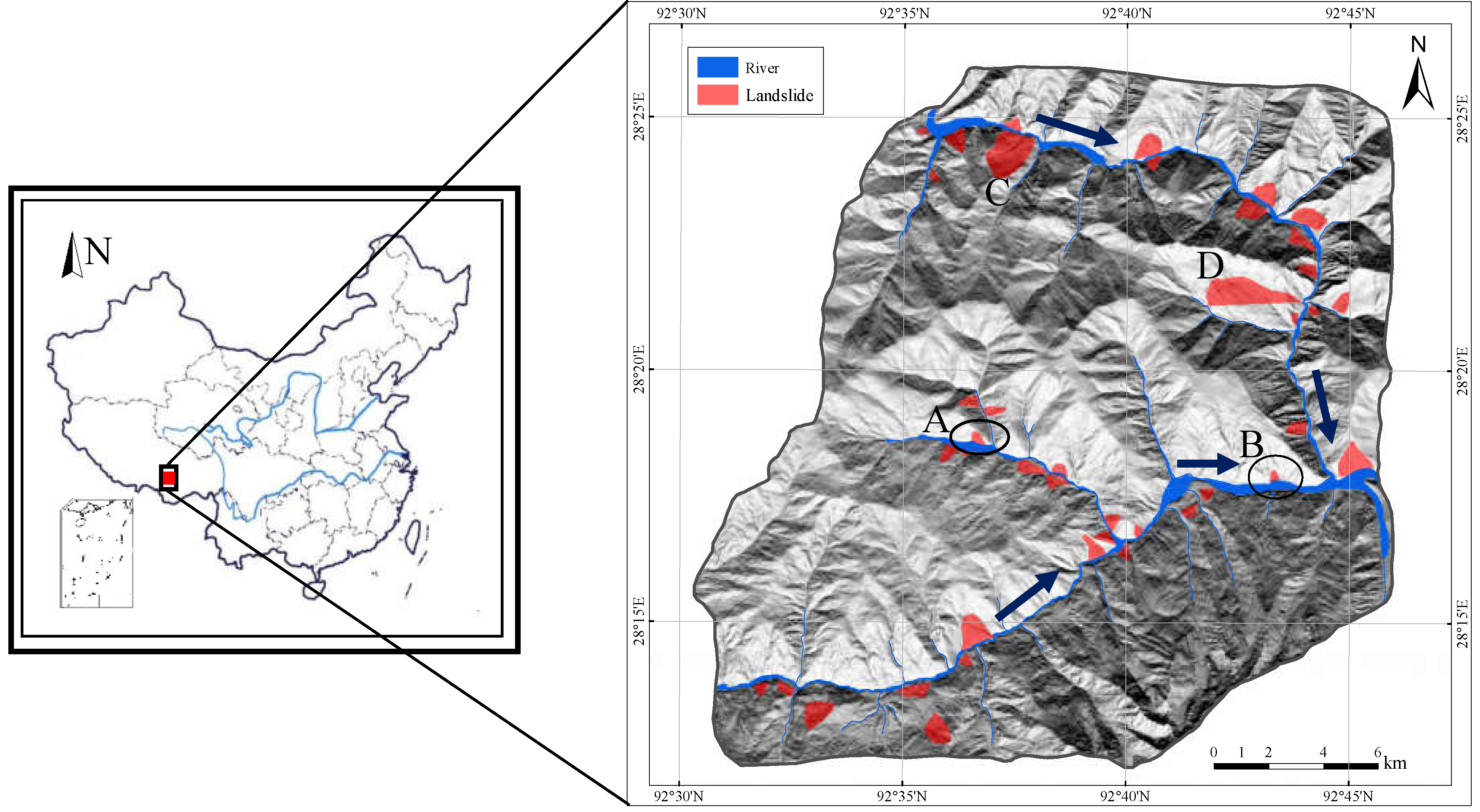
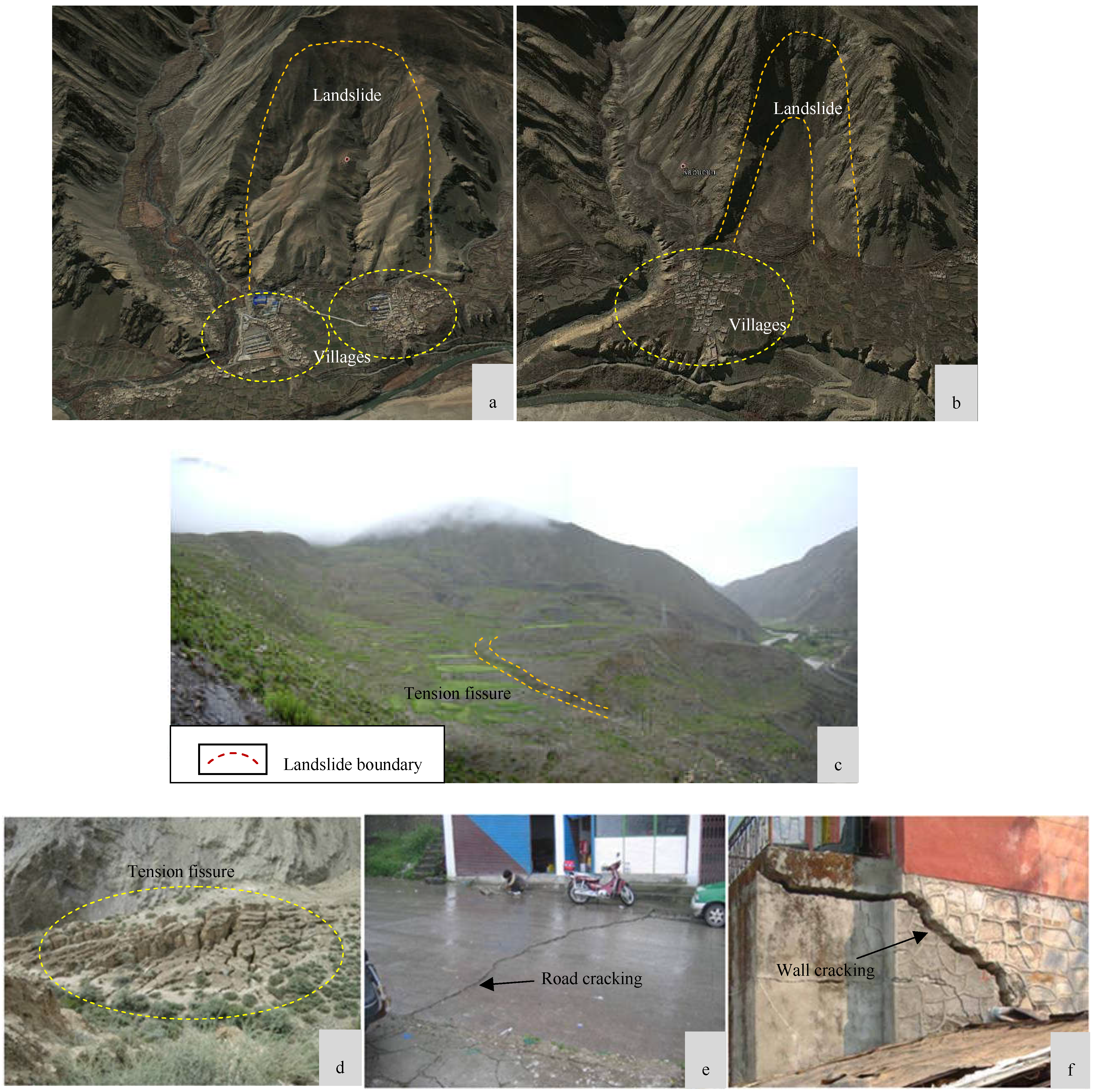

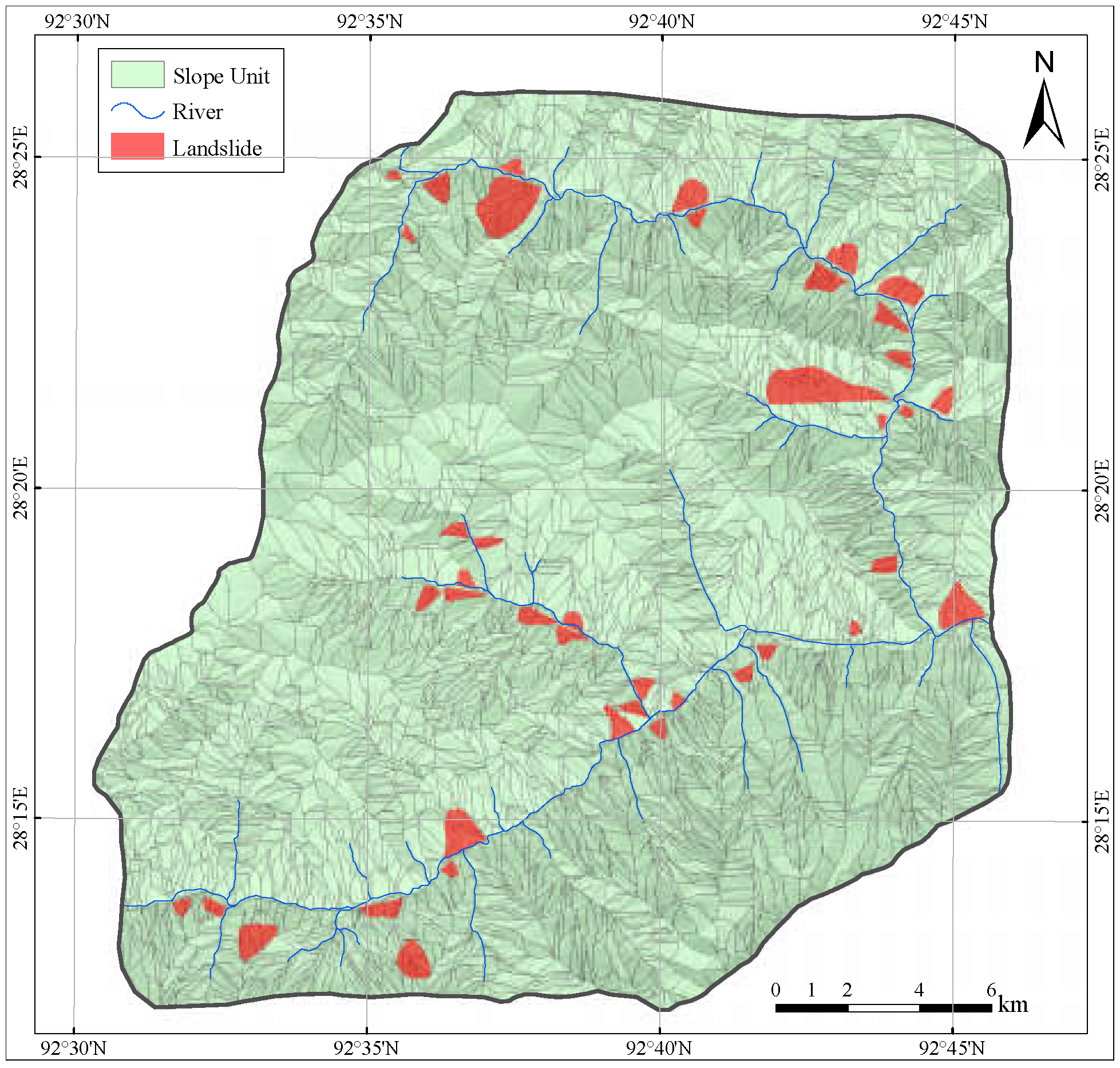

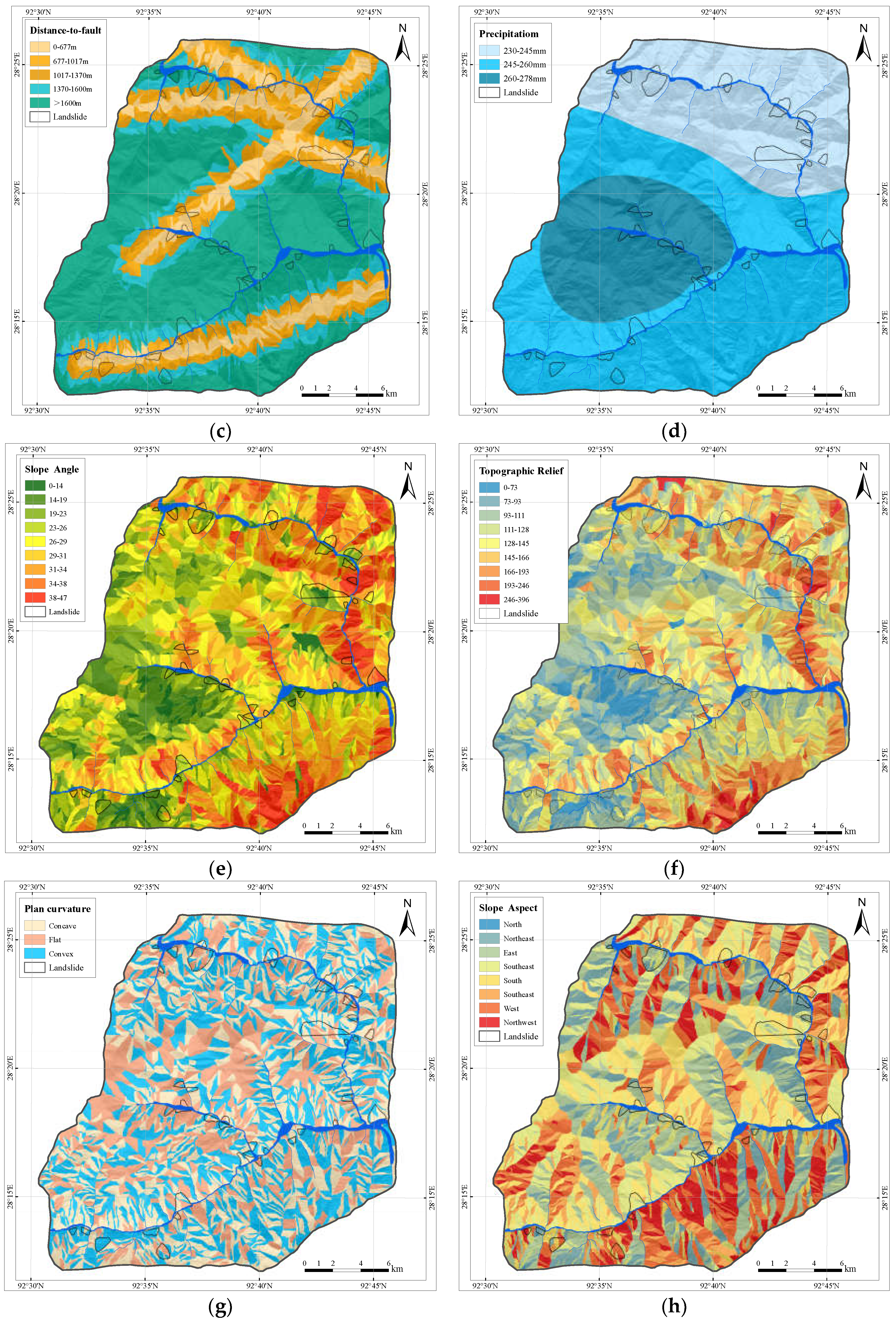
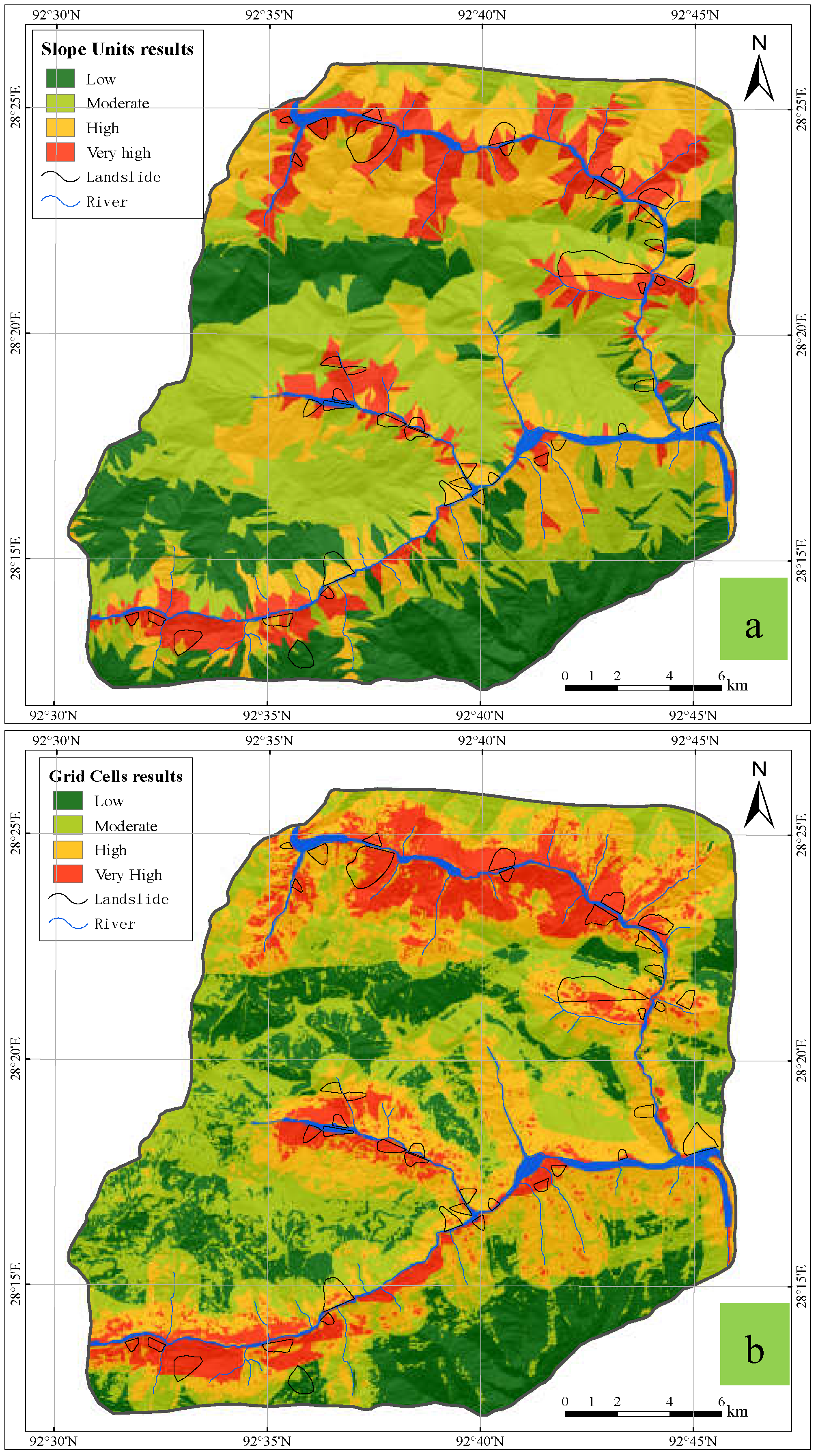
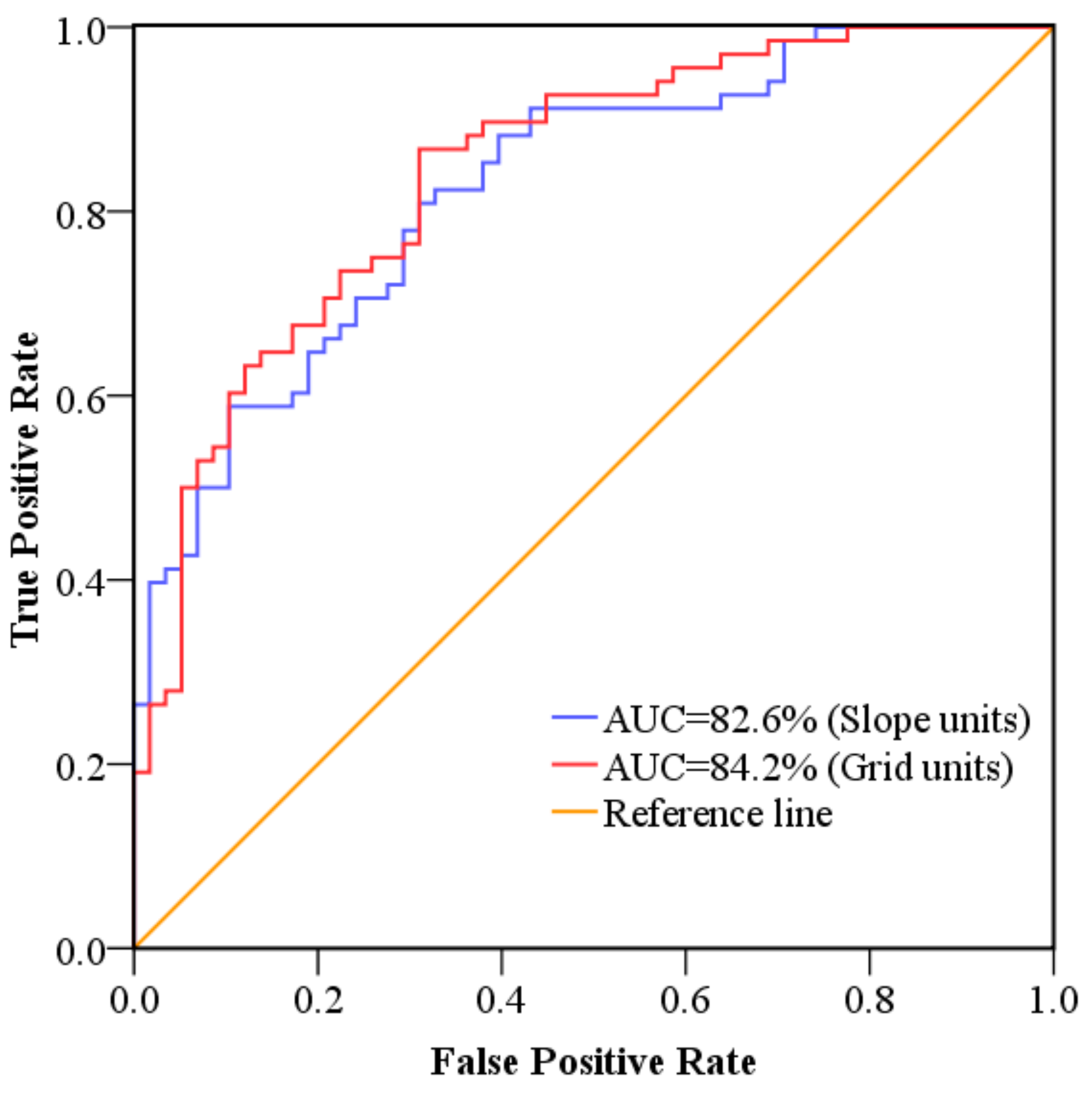
| Importance Scale | Meaning |
|---|---|
| 1 | ai has the same importance as aj |
| 3 | ai is slightly more important than aj |
| 5 | ai is significantly more important than aj |
| 7 | ai is much more strongly important than aj |
| 9 | ai is extremely more important than aj |
| 2, 4, 6, 8 | Represents the intermediate value of the above Judgement |
| n | 1 | 2 | 3 | 4 | 5 | 6 | 7 | 8 | 9 | 10 | 11 |
|---|---|---|---|---|---|---|---|---|---|---|---|
| 0 | 0 | 0.58 | 0.90 | 1.12 | 1.24 | 1.32 | 1.41 | 1.45 | 1.49 | 1.51 |
| Heading | X1 | X2 | X3 | X4 | X5 | X6 | X7 | X8 | Weights |
|---|---|---|---|---|---|---|---|---|---|
| X1 | 1 | 1 | 2 | 3 | 3 | 4 | 7 | 9 | 0.2544 |
| X2 | 1 | 1 | 2 | 3 | 3 | 4 | 7 | 9 | 0.2544 |
| X3 | 1/2 | 1/2 | 1 | 2 | 2 | 3 | 6 | 8 | 0.1645 |
| X4 | 1/3 | 1/3 | 1/2 | 1 | 1 | 2 | 5 | 7 | 0.1050 |
| X5 | 1/3 | 1/3 | 1/2 | 1 | 1 | 2 | 5 | 7 | 0.1050 |
| X6 | 1/4 | 1/4 | 1/3 | 1/2 | 1/2 | 1 | 4 | 6 | 0.0698 |
| X7 | 1/7 | 1/7 | 1/6 | 1/5 | 1/5 | 1/4 | 1 | 3 | 0.0291 |
| X8 | 1/9 | 1/9 | 1/8 | 1/7 | 1/7 | 1/6 | 1/3 | 1 | 0.0176 |
| Factor | Class | Landslide Not Occurred | Landslide Occurred | Total Count | Information Content | ||
|---|---|---|---|---|---|---|---|
| Count | Ratio/% | Count | Ratio/% | ||||
| Lithology | 100,097 | 0.02 | 3304 | 0.02 | 103,401 | −0.0589 | |
| 73,734 | 0.01 | 9919 | 0.06 | 83,653 | 1.2524 | ||
| J3w | 701,858 | 0.14 | 28,572 | 0.16 | 730,430 | 0.1434 | |
| J2z | 1,249,709 | 0.25 | 41,863 | 0.24 | 1,291,572 | −0.0446 | |
| J2lr | 1,128,142 | 0.23 | 23,619 | 0.13 | 1,151,761 | −0.5024 | |
| J1r | 1,053,208 | 0.21 | 51,839 | 0.30 | 1,105,047 | 0.3251 | |
| K1l | 528,129 | 0.11 | 9521 | 0.05 | 537,650 | −0.6491 | |
| T3n | 163,656 | 0.03 | 6712 | 0.04 | 170,368 | 0.1505 | |
| Distance-to-River/m | 0–396 | 839,391 | 0.17 | 68,334 | 0.39 | 907,725 | 0.7981 |
| 396–629 | 623,944 | 0.12 | 46,396 | 0.26 | 670,340 | 0.7140 | |
| 629–1000 | 1,095,600 | 0.22 | 44,388 | 0.25 | 1,139,988 | 0.1388 | |
| >1000 | 2,439,594 | 0.49 | 16,235 | 0.09 | 2,455,829 | −1.6344 | |
| Distance-to-Fault/m | 0–677 | 625,294 | 0.13 | 40,170 | 0.23 | 665,464 | 0.5772 |
| 677–1017 | 534,944 | 0.11 | 30,329 | 0.17 | 565,273 | 0.4594 | |
| 1017–1370 | 511,669 | 0.10 | 19,977 | 0.11 | 531,646 | 0.1032 | |
| 1370–1600 | 825,477 | 0.17 | 26,357 | 0.15 | 851,834 | −0.0911 | |
| >1600 | 2,501,149 | 0.50 | 58,516 | 0.33 | 2,559,665 | −0.3937 | |
| Precipitation/mm | 0–245 | 1,433,091 | 0.29 | 89,925 | 0.51 | 1,523,016 | 0.5551 |
| 245–260 | 2,503,337 | 0.50 | 60,808 | 0.35 | 2,564,145 | −0.3571 | |
| 260–278 | 1,062,105 | 0.21 | 24,616 | 0.14 | 1,086,721 | 0.0551 | |
| Slope Angle/° | 0–14 | 111,669 | 0.02 | 9234 | 0.05 | 120,903 | 0.8125 |
| 14–19 | 404,744 | 0.08 | 14,696 | 0.08 | 419,440 | 0.0333 | |
| 19–23 | 546,682 | 0.11 | 40,019 | 0.23 | 586,701 | 0.6994 | |
| 23–26 | 726,071 | 0.15 | 28,815 | 0.16 | 754,886 | 0.1189 | |
| 26–29 | 789,023 | 0.16 | 18,016 | 0.10 | 807,039 | −0.4175 | |
| 29–31 | 809,161 | 0.16 | 19,855 | 0.11 | 829,016 | −0.3472 | |
| 31–34 | 702,254 | 0.14 | 23,853 | 0.14 | 726,107 | −0.0312 | |
| 34–38 | 545,874 | 0.11 | 13,447 | 0.08 | 559,321 | −0.3434 | |
| 38–47 | 363,055 | 0.07 | 7414 | 0.04 | 370,469 | −0.5268 | |
| Topographic relief | 0–73 | 222,641 | 0.04 | 11,363 | 0.06 | 234,004 | 0.3596 |
| 73–93 | 469,259 | 0.09 | 20,128 | 0.11 | 489,387 | 0.1936 | |
| 93–111 | 794,321 | 0.16 | 35,505 | 0.20 | 829,826 | 0.2331 | |
| 111–128 | 946,833 | 0.19 | 24,052 | 0.14 | 970,885 | −0.3134 | |
| 128–145 | 892,467 | 0.18 | 36,891 | 0.21 | 929,358 | 0.1581 | |
| 145–166 | 777,605 | 0.16 | 25,008 | 0.14 | 802,613 | −0.0841 | |
| 166–193 | 528,299 | 0.11 | 8327 | 0.05 | 536,626 | −0.7812 | |
| 193–246 | 292,790 | 0.06 | 13,895 | 0.08 | 306,685 | 0.2903 | |
| 246–396 | 74,318 | 0.01 | 180 | 0.00 | 74,498 | −2.6410 | |
| Plan Curvature | <−0.01 | 1,814,217 | 0.36 | 63,302 | 0.36 | 1,877,519 | −0.0052 |
| −0.01–0.01 | 1,365,686 | 0.27 | 46,365 | 0.26 | 1,412,051 | −0.0317 | |
| >0.01 | 1,818,630 | 0.36 | 65,682 | 0.37 | 1,884,312 | 0.0281 | |
| Slope Aspect | North | 10,337 | 0.00 | 109 | 0.00 | 10,446 | −1.1780 |
| Northeast | 570,240 | 0.11 | 22,379 | 0.13 | 592,619 | 0.1082 | |
| East | 894,047 | 0.18 | 29,250 | 0.17 | 923,297 | −0.0675 | |
| Southeast | 894,555 | 0.18 | 39,613 | 0.23 | 934,168 | 0.2241 | |
| South | 714,674 | 0.14 | 43,930 | 0.25 | 758,604 | 0.5357 | |
| Southwest | 643,541 | 0.13 | 14,653 | 0.08 | 658,194 | −0.4203 | |
| West | 800,088 | 0.16 | 16,831 | 0.10 | 816,919 | −0.4977 | |
| Northwest | 471,051 | 0.09 | 8584 | 0.05 | 479,635 | −0.6385 | |
| Susceptibility | Landslide Occurred | Total Study Area | ||||
|---|---|---|---|---|---|---|
| Count | Ratio (%) | Area (km2) | Count | Ratio (%) | Area (km2) | |
| Low | 8093 | 4.62 | 0.81 | 1,177,713 | 22.76 | 117.68 |
| Moderate | 22,744 | 12.97 | 2.27 | 1,999,249 | 38.64 | 199.77 |
| High | 75,061 | 42.81 | 7.50 | 1,423,380 | 27.51 | 142.23 |
| Very High | 69,455 | 39.61 | 6.94 | 573,540 | 11.09 | 57.31 |
| Susceptibility | Landslide Occurred | Total Study Area | ||||
|---|---|---|---|---|---|---|
| Count | Ratio (%) | Area (km2) | Count | Ratio (%) | Area (km2) | |
| Low | 5605 | 3.20 | 0.56 | 1,116,341 | 21.59 | 111.62 |
| Moderate | 13,558 | 7.73 | 1.35 | 1,669,578 | 32.29 | 166.93 |
| High | 70,954 | 40.46 | 7.09 | 1,573,986 | 30.44 | 157.38 |
| Very High | 85,235 | 48.61 | 8.52 | 810,840 | 15.68 | 81.07 |
© 2017 by the authors. Licensee MDPI, Basel, Switzerland. This article is an open access article distributed under the terms and conditions of the Creative Commons Attribution (CC BY) license (http://creativecommons.org/licenses/by/4.0/).
Share and Cite
Wang, F.; Xu, P.; Wang, C.; Wang, N.; Jiang, N. Application of a GIS-Based Slope Unit Method for Landslide Susceptibility Mapping along the Longzi River, Southeastern Tibetan Plateau, China. ISPRS Int. J. Geo-Inf. 2017, 6, 172. https://doi.org/10.3390/ijgi6060172
Wang F, Xu P, Wang C, Wang N, Jiang N. Application of a GIS-Based Slope Unit Method for Landslide Susceptibility Mapping along the Longzi River, Southeastern Tibetan Plateau, China. ISPRS International Journal of Geo-Information. 2017; 6(6):172. https://doi.org/10.3390/ijgi6060172
Chicago/Turabian StyleWang, Fei, Peihua Xu, Changming Wang, Ning Wang, and Nan Jiang. 2017. "Application of a GIS-Based Slope Unit Method for Landslide Susceptibility Mapping along the Longzi River, Southeastern Tibetan Plateau, China" ISPRS International Journal of Geo-Information 6, no. 6: 172. https://doi.org/10.3390/ijgi6060172






